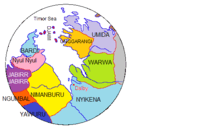Worrorra language
Worrorra (Worora), or Western Worrorran, is a moribund Australian Aboriginal language of northern Western Australia.
| Worrorra | |
|---|---|
| Region | Western Australia |
| Ethnicity | Worrorra, Unggumi, Yawijibaya, Unggarranggu, Umiida |
Native speakers | 7 (2016 census)[1] |
Wororan
| |
| Dialects |
|
| Worora Kinship Sign Language | |
| Language codes | |
| ISO 639-3 | Variously:wro – Worrorraxgu – Unggumixud – Umiidaxun – Unggarranggujbw – Yawijibaya |
| Glottolog | west2435[3] |
| AIATSIS[4] | K17 Worrorra, K14 Unggumi, K49 Umiida, K55 Unggarrangu, K53 Yawijibaya |
 Map of the traditional lands of Australian Aboriginal tribes around Derby, Western Australia. Worrorra includes the orange and lavender.[5] | |
Worrorra is a dialect cluster; Bowern (2011) recognizes five languages: Worrorra proper, Unggumi, Yawijibaya, Unggarranggu, and Umiida.[6]
An alleged Maialnga language was a reported clan name of Worrorra proper that could not be confirmed with speakers.[7]
Elkin Umbagai was a translator between English and Worrorra.[8]
Sounds
| Bilabial | Interdental | Alveolar | Retroflex | Palatal | Velar | |
|---|---|---|---|---|---|---|
| Stop | p | t̪ | t | ʈ | c | k |
| Nasal | m | n̪ | n | ɳ | ɲ | ŋ |
| Trill/Flap | ɾ~r | |||||
| Lateral | l | ɭ | ʎ | |||
| Approximant | w | ɻ | j |
- A nasal occurring before a stop consonant, is then realised as a prenasalized voiced stop sound (ex. [ŋɡ]).
- /r/ can be heard as a trill or a flap, and is typically only voiced when preceding a sonorant, voiced phoneme, or lateral consonant. Elsewhere, it is voiceless as [r̥], or can be heard in free variation.
- /j/ can also be heard as a fricative sound [ç] in word-initial positions.
Worrorra vowel inventory[9]
| Front | Central | Back | |
|---|---|---|---|
| High | i | u | |
| Mid | e | o | |
| Low | a |
- Long vowel sounds are noted as follows: /iː, ɛː, uː, ɔː, ɑː/.
- In between consonant clusters, an epenthetic vowel sound [ʉ̆] ~ [ɨ̆] occurs when breaking them up. Sometimes it can also be heard as a central vowel sound [ɨ].[10]
| Phoneme | Allophones[10] |
| /i/ | [i], [ɪ] |
| /a/ | [a], [ɒ], [æ], [ɛ̞], [ɑ], [ɐ] |
| /u/ | [u], [y], [ʊ] |
| /iː/ | [iː], [ɪː] |
| /ɛː/ | [eɪ], [ɛː] ~ [eː] |
| /ɑː/ | [ɑˑɪ], [ɑ] |
| /ɔː/ | [oʊ], [ɔː] ~ [ɒː] |
| /uː/ | [uː], [ʊː] |
Sign language
The Worora have (or at one point had) a signed form of their language, used for speaking to kin in certain taboo relationships,[11] but it is not clear from records that it was particularly well developed compared to other Australian Aboriginal sign languages.[12]
Bibliography
- Clendon, Mark (2014), Worrorra: a language of the north-west Kimberley coast, University of Adelaide Press
References
- "Census 2016, Language spoken at home by Sex (SA2+)". stat.data.abs.gov.au. ABS. Retrieved 30 October 2017.
- Clendon (1994, 2000), Love (2000), cited in Dixon 2002
- Hammarström, Harald; Forkel, Robert; Haspelmath, Martin, eds. (2017). "Western Worrorran". Glottolog 3.0. Jena, Germany: Max Planck Institute for the Science of Human History.
- K17 Worrorra at the Australian Indigenous Languages Database, Australian Institute of Aboriginal and Torres Strait Islander Studies (see the info box for additional links)
- map is indicative only.
- Bowern, Claire. 2011. "How Many Languages Were Spoken in Australia? Archived 2012-08-15 at the Wayback Machine", Anggarrgoon: Australian languages on the web, December 23, 2011 (corrected Archived 2012-07-03 at the Wayback Machine February 6, 2012)
- Tindale, Norman B. (Norman Barnett); Jones, Rhys (1974), Aboriginal tribes of Australia : their terrain, environmental controls, distribution, limits, and proper names, University of California Press ; Canberra : Australian National University Press, ISBN 978-0-520-02005-4
- Valda J. Blundell and Mary Anne Jebb. "Umbagai, Elkin (1921–1980)". Australian Dictionary of Biography. Retrieved 4 November 2013.
- Capell, Arthur; Coate, Howard H. J. (1984). Comparative studies in Northern Kimberley languages. Pacific Linguistics Series C. Canberra: Pacific Linguistics. ISBN 0-85883-314-X.
- Clendon, Mark (2014). Worrorra: A language of the north-west Kimberley coast. Adelaide: University of Adelaide. pp. 24–39.
- Love, J.R.B. (1941). Worora kinship gestures, Reprinted in Aboriginal sign languages of the Americas and Australia. New York: Plenum Press, 1978, vol. 2, pp. 403–405.
- Kendon, A. (1988) Sign Languages of Aboriginal Australia: Cultural, Semiotic and Communicative Perspectives. Cambridge: Cambridge University Press
This article is issued from Wikipedia. The text is licensed under Creative Commons - Attribution - Sharealike. Additional terms may apply for the media files.